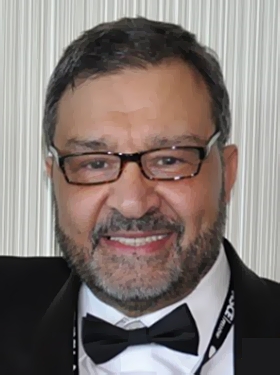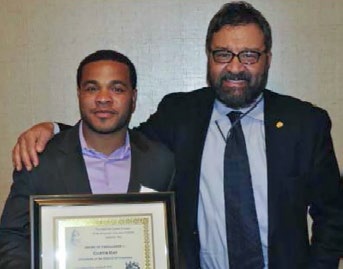Dr. Z’s Corner (202101)
The Amazing True Story of a Former Student and Fresh PE: “Finally, a Sense of Accomplishment”
The new year is just around the corner and for my January 2021 article I’ve decided to share an inspirational story of a former student and a real Washingtonian, Curtis Day, a fresh Professional Engineer:
“I remember my high school graduation day as if it was yesterday. I recall how everyone seemed so happy, excited, and had a sense of completion. In contrast, I found myself locked in deep thought, unable to enjoy the moment, as I contemplated what was next. My perspective was a sense of urgency. For me things were just getting started, and I realized that I did not have a solid plan for my future.
College was such an unknown to me at the time, and I didn’t see the benefit of attending college. The men in my family were all self-employed or entrepreneurs, I was taught to learn a trade and be independent. I went to work for my father after high school, learning the HVAC trade and obtaining my Commercial Drivers License.
I worked as an HVAC technician and heating oil delivery driver until I was 27 years old. Working in the family business has its challenges and my mom kept encouraging me to just enroll in a class. She told me to just try it out for one semester, what did I have to lose? Then I started the process of enrolling for the Spring 2011 semester at The University of the District of Columbia. The choice to attend UDC was very simple, Washington, DC has several local universities, however UDC was the only one who had affordable tuition in the area. I started the process of enrolling myself, but I had no idea what was in store for me. First, locating high school transcripts after being out of school for nearly 10 years is not easy. Second, I never failed any class in high school, but since I never had any aspirations of going to college I skated by and did just enough to pass and get out.
I remember the day I took my application and transcript to the enrollment office. My son was 2 years old at the time and he was with me, I went into the office, handed over my papers, and sat down. The person in charge at the desk proceeded to calculate my GPA and informed me that I didn’t meet the minimum requirements for entry into the University and that I would have to start at community college.
I never forgot how my feelings were hurt and I felt a sense of rejection. My first thought was to go back to what was working for me and give up this whole college dream. I felt totally discouraged, but after talking to my mother she convinced me to continue with the process. I ended up taking a placement test later that week, and after I finished, I was called into the office. I wasn’t sure what was going on, but I found out that I had scored pretty high on the placement test. I told the advisor that it was recommended that I start in Community College and she printed out my test scores and gave me instructions to return back to the University. I had scored high enough to enter the University after all.
I remember my first semester at college. I particularly remember Calculus class because I was so unsure of how I would perform. I had always been pretty good at math, but Calculus was always tough. I still have the first exam I took in my calculus class, I received and A and it has always been my reminder that I belong.
I remember meeting Dr. Z and Dr. Behera. They stressed the importance of the FE Exam and the PE Exam, what seemed like everyday. They both guided me through my college experience making sure I not only learned the material, but that I was prepared to enter the workforce. I remember my college graduation day, once again the same atmosphere of jubilee and relief surrounded me. Even though I had completed my studies with the honor of Summa Cum Laude, I felt a sense of urgency, even more so than on my high school graduation day.
I had spent the previous 4.5 years on a path to change my career and now it was show time. I remember getting my FE Exam results shortly after graduation, but still not relief. I had a sense of anxiety to get into industry and prove that I belonged. At the time I had three job offers, and I chose to join the Boeing Company in Everett, Washington. At the time I worked with the team responsible for the design of the Cargo System on the 777-9 Commercial Airplane. After working in the aerospace industry for 2 years, I realized that I was not working in the field of engineering that I loved. I decided to resign and move back to DC and pursue a lifelong career as a Civil Engineer in the Water Resource discipline.
I am now employed with an engineering firm in the D.C. metro area, working with a team on land development projects. I am responsible for Stormwater Management/Storm Drain Design, Water and Sewer Main Design, Erosion Sediment Control Design, Flood Plain Mapping, and various other tasks related to land development.
I was first scheduled to take my PE exam in April 2020, but due to Covid-19 it was cancelled. I eventually ended up taking the exam in October 2020, and I am pleased to announce to the world that I received a passing score on my first attempt. I am also pleased to announce that I finally felt a sense of accomplishment. I feel like passing the PE exam and obtaining my PE License, will be something that I will remember forever and will be a major stepping stone for myself and my family.
I hope to be an inspiration to others and be an example of why it is never too late to do anything in life.
Pursue your dreams, never give up, work until you feel a sense of accomplishment, enjoy it for a moment, and keep building. Curtis Day, PE .”
Wishing all of you health, wealth, and happiness in 2021.
Until next time,
Ahmet Zeytinci (Dr.Z.)
This email address is being protected from spambots. You need JavaScript enabled to view it.










